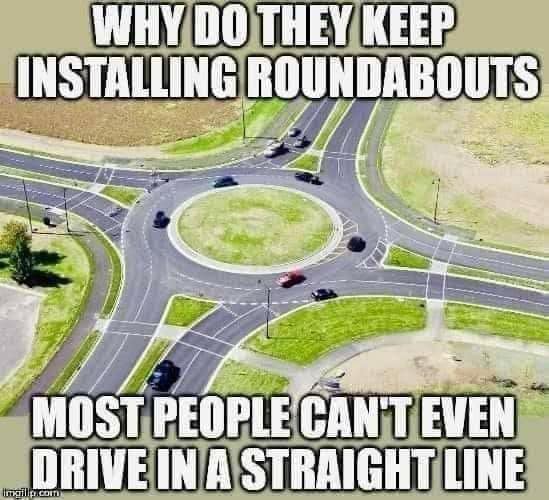Roundabouts are popping up more and more on roads throughout the United States. Some drivers appreciate their smooth flow, while others approach them with hesitation, unsure of how they work. So, what exactly are roundabouts, and why are cities across the country choosing them over traditional intersections? These circular intersections aren’t just about looking modern—they’re designed to make roads safer, reduce accidents, and improve traffic flow. As American communities look for smarter and safer roadway solutions, roundabouts are playing a key role in reshaping how we get from point A to point B.

At their core, roundabouts are circular intersections where traffic moves in a counterclockwise direction around a center island. Unlike traditional intersections with stop signs or traffic lights, roundabouts use a yield-at-entry system. This means drivers entering the roundabout must yield to vehicles already circulating. The design naturally slows vehicles down and encourages a smoother flow of traffic, making them safer for drivers and pedestrians alike. Many roundabouts are built with pedestrian crosswalks and raised splitter islands that help slow cars down and give people on foot safer crossing points.
While roundabouts might seem like a modern invention, their history goes back centuries. Circular intersections first appeared in European cities like Bath, England, and Paris, France, in the 1700s. Even in the United States, early versions of circular roadways were included in Pierre L’Enfant’s original design for Washington, D.C. However, these early traffic circles didn’t have the yield rules and safety features we see in modern roundabouts today. The big change came in the 1950s when British engineers introduced yield-at-entry rules. By requiring incoming drivers to give the right of way to circulating traffic, congestion and accidents decreased dramatically. These improvements led to the widespread adoption of roundabouts in Europe and Australia. It wasn’t until the 1990s that the U.S. started to embrace the idea, with the first modern roundabout built in Summerlin, Nevada, in 1990. Since then, the U.S. has installed over 10,000 roundabouts across the country.
One of the main reasons roundabouts are gaining popularity is because of their impressive safety benefits. Traditional intersections, especially those controlled by stop signs or traffic signals, have many conflict points—places where cars might cross paths and potentially collide. A four-way intersection has 32 conflict points, which increases the risk of serious crashes, including dangerous right-angle or “T-bone” collisions. Roundabouts, on the other hand, reduce these conflict points to just eight. The curved layout of roundabouts means vehicles enter and exit at an angle, which lowers the chances of severe crashes. According to the Federal Highway Administration (FHWA), converting a stop-controlled intersection to a roundabout can reduce serious and fatal crashes by 90%. Even replacing signalized intersections with roundabouts cuts serious and fatal crashes by nearly 80%.
But roundabouts don’t just make roads safer—they make them more efficient too. Unlike traffic lights, which force vehicles to stop and wait, roundabouts encourage continuous movement. Drivers spend less time idling, which reduces congestion, especially during rush hours. This constant flow of traffic also leads to better fuel efficiency because cars aren’t starting and stopping as frequently. Fewer stops mean less fuel burned and lower vehicle emissions, making roundabouts a greener choice for cities looking to reduce their carbon footprint. On top of that, roundabouts make U-turns easier, adding flexibility for drivers who might have missed a turn.
You’ll most often find roundabouts in areas with heavy traffic or a history of accidents. Many city planners are choosing roundabouts over traditional intersections to improve safety and traffic flow. Some states, like New York and Virginia, even have policies requiring roundabouts to be considered first in new road projects. Florida is another leader in roundabout adoption, with roughly 750 currently in use. However, states with lower populations, like North Dakota, South Dakota, and Wyoming, have fewer roundabouts—less than 50 between them.
Despite all the benefits, not everyone is sold on roundabouts. Some drivers find them confusing or intimidating, especially if they’ve never driven through one before. Understanding how to yield properly, stay in the correct lane, and signal when exiting can take some practice. However, studies show that once people become familiar with roundabouts, their opinions often change for the better. Communities that initially opposed roundabouts tend to support them once they experience the improvements firsthand.
Roundabouts are becoming a permanent fixture in America’s transportation system. In just two decades, the number of roundabouts in the U.S. has grown from 356 in 2000 to over 10,000 today. The FHWA continues to recommend roundabouts as the safest option for intersections, and more states are including them in their transportation planning. As public understanding grows and designs continue to improve, roundabouts are expected to become even more common in the years ahead.
In the end, roundabouts are about more than just traffic management. They represent a forward-thinking approach to safer, more efficient, and more environmentally friendly roadways. While some drivers may still feel uncertain when approaching a roundabout, the proven benefits in safety, fuel savings, and reduced emissions make them a smart solution for modern transportation. The next time you find yourself driving through one, take a moment to appreciate the simple genius behind its design—it’s making roads safer and better for everyone.





